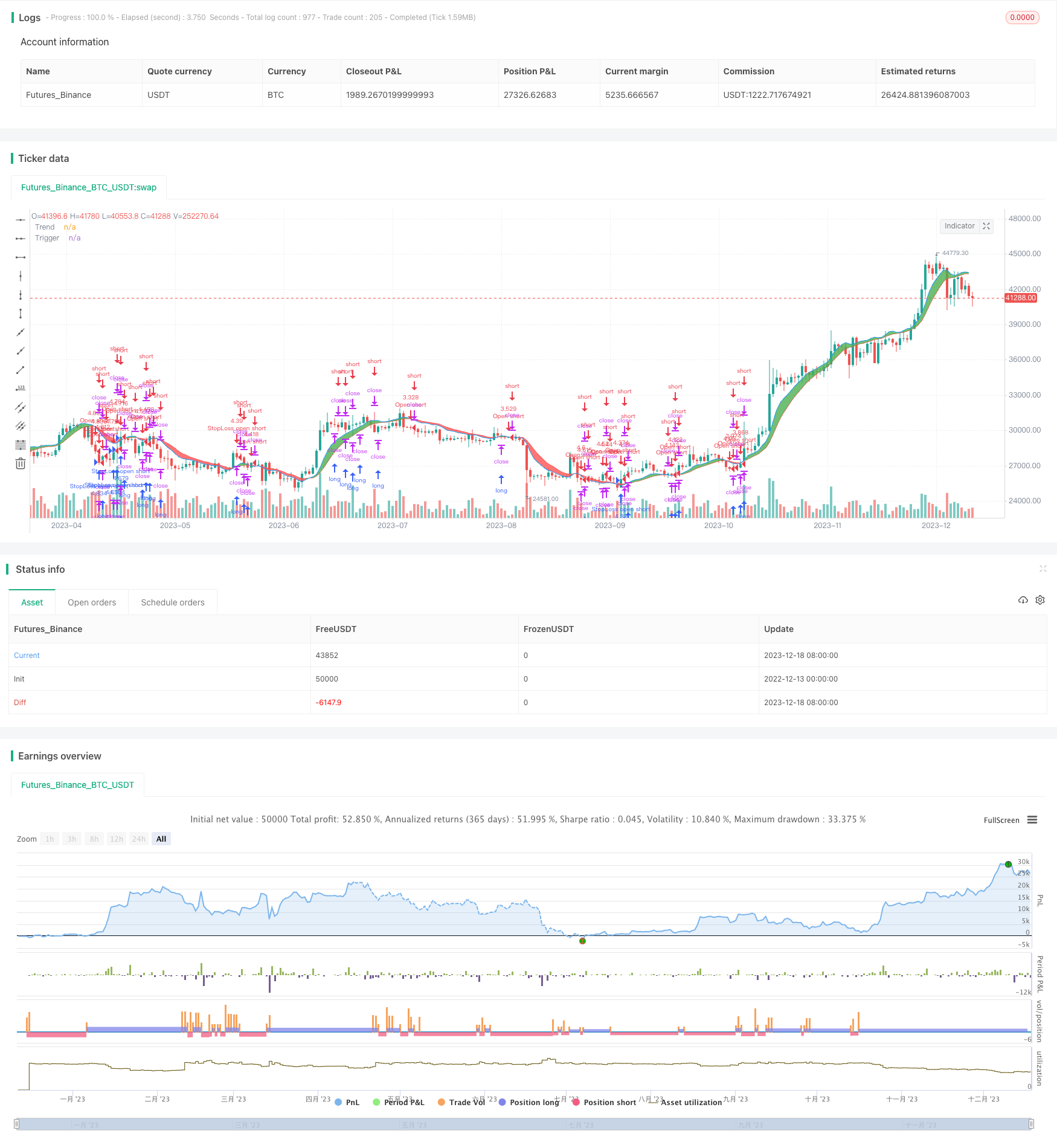
개요
엘러스의 즉각적인 트렌드 라인 전략은 존 엘러스가 그의 책상 주식과 선물에 대한 제어 분석 에서 제시했다. 이 전략은 기술 지표를 사용하여 주식이나 선물의 즉각적인 트렌드를 식별하고 트렌드가 역전되면 포지션을 열는다.
전략 원칙
이 전략의 핵심은 즉각적인 트렌드 라인을 계산하는 것입니다. IT 라인의 계산 공식은 다음과 같습니다.
it := (a-((a*a)/4.0))*src+0.5*a*a*src[1]-(a-0.75*a*a)*src[2]+2*(1-a )*it[1]-(1-a )*(1-a )*it[2]
여기서 src는 가격을 나타내고, a는 평준화 인자이며, 기본값은 0.07이다. 이 공식은 가격을 평준화하고 트렌드를 생성할 수 있는 2단 필터이다.
또 다른 중요한 지표는 지연선 ((lag)) 이며, 계산 공식은 다음과 같다:
lag = 2.0 * it - nz(it[2])
이 선은 IT 선의 한 주기 뒤떨어진다. 가격이 상단에서 뒤떨어지면, 트렌드가 반전되어 더 많은 것을 얻는다. 가격이 하단에서 뒤떨어지면, 트렌드가 반전되어 더 많은 것을 얻는다.
이 전략은 또한 위험을 통제하기 위해 스톱로스 유닛을 설정합니다.
우위 분석
이 전략은 다음과 같은 장점을 가지고 있습니다.
- 트렌드를 파악하는 IT 와이어를 사용하여 시장 소음을 효과적으로 필터링하여 신호 품질을 향상시킵니다.
- 2단 필터를 적용, 파라미터 최적화 공간이 넓고 조정성이 높다
- 트렌드 중 반복적으로 마이너스를 피하기 위해 트레이드 신호를 생성하기 위해 뒤떨어진 라인을 결합합니다.
- 스톱 손실 단위 리스크를 설정하여 스톱 손실 비율을 미리 설정할 수 있습니다.
- 코드 구조는 명확하고 이해하기 쉽고 수정하기 쉽습니다.
위험 분석
이 전략에는 몇 가지 위험도 있습니다.
- IT 라인 및 지연 라인 파라미터를 잘못 설정하면 잘못된 신호가 발생할 수 있습니다.
- 스톱포인트 설정이 잘못되면 너무 일찍 또는 너무 많이 스톱포인트 할 수 있습니다.
- 거래 빈도가 높을 수 있으며 거래 비용이 수익에 영향을 미칠 수 있습니다.
- 집중 포지션 보유 기간이 너무 길면 수익률에 영향을 미칠 수 있다.
이러한 위험은 다음과 같은 방법으로 줄일 수 있습니다.
- 기계 학습 알고리즘 최적화 파라미터를 적용
- 자율적 정지 지점을 설정
- 포지션 개시 수를 적절히 조정하고 거래 빈도를 낮추는 것
- 포지션 주기 중지 설정
최적화 방향
이 전략은 다음과 같은 방향으로 최적화될 수 있습니다.
- 다른 필터 변수의 결과에 대한 영향을 테스트하고 최적의 변수를 찾습니다.
- 다른 지표와 결합하여 거래 신호를 필터링하여 신호 품질을 향상 시키십시오.
- 포지션 개시 논리를 최적화하여 트렌드 가속화 시 포지션을 늘립니다.
- 시장의 변동에 따라 스톱포드를 조정하는 적응형 스톱포드 전략을 설정합니다.
- 거래 시간 및 주기적으로 결과에 영향을 미치는 시간 순서 분석을 수행합니다.
결론적으로
전반적으로, 엘러스의 순간 트렌드 라인 전략은 기술 지표를 사용하여 주식 / 선물의 실시간 트렌드를 식별하고 트렌드가 역전되면 입장을 열습니다. 효과적인 잡음 필터링, 높은 매개 변수 조정성, 명확한 신호 생성 논리 및 내장 된 위험 제어와 같은 장점이 있습니다. 매개 변수 선택, 필터링, 포지션 규모 및 스톱 리조팅을 추가로 최적화하여 이 전략은 더 나은 성능을 얻을 수 있습니다. 명확한 코드 구조는 또한 이해하기 쉽고 수정 할 수 있습니다.
/*backtest
start: 2022-12-13 00:00:00
end: 2023-12-19 00:00:00
period: 1d
basePeriod: 1h
exchanges: [{"eid":"Futures_Binance","currency":"BTC_USDT"}]
*/
//@version=3
strategy("Ehlers Instantaneous Trendline Strategy", shorttitle = "Ehlers Instantaneous Trendline Strategy", overlay = true, default_qty_type = strategy.percent_of_equity, default_qty_value = 100.0, pyramiding = 1, backtest_fill_limits_assumption = 1)
src = input(hl2, title="Source")
a = input(0.07, title="Alpha", step=0.01)
fr = input(false, title="Fill Trend Region")
it = na
if (na(it[2]) or na(it[1]))
it := (src + 2 * src[1] + src[2]) / 4.0
else
it := (a-((a*a)/4.0))*src+0.5*a*a*src[1]-(a-0.75*a*a)*src[2]+2*(1-a )*it[1]-(1-a )*(1-a )*it[2]
lag = 2.0 * it - nz(it[2])
rngFrac = input(0.35)
revPct = input(0.015)
stopType = input(title="Stop type", defval = "stop-order", options = ["stop-order", "market-order", "None"])
diff = input(0.5, title = "Spread")
LongPrice(p) =>
LongPrice = diff == 0 ? p : floor(p / diff) * diff
ShortPrice(p) =>
ShortPrice = diff == 0 ? p : ceil(p / diff) * diff
strategy.cancel_all()
reverseTrade = false
if stopType == "market-order"
if strategy.position_size > 0 and close < strategy.position_avg_price * (1 - revPct)
strategy.order("StopLoss open short", strategy.short, 2 * strategy.position_size, limit = close - 2 * diff)
reverseTrade := true
if strategy.position_size < 0 and close > strategy.position_avg_price * (1 + revPct)
strategy.order("StopLoss open long", strategy.long, -2 * strategy.position_size, limit = close + 2 * diff)
reverseTrade := true
if lag > it and not reverseTrade
price = LongPrice(max(close - (high - low) * rngFrac, low))
if strategy.position_size <= 0
strategy.order("Open long", strategy.long, strategy.equity / price - strategy.position_size, limit = price)
if stopType == "stop-order"
strategy.order("StopLoss open long", strategy.short, 2 * strategy.equity / price, stop = ShortPrice(price * (1 - revPct)))
else
if stopType == "stop-order"
strategy.order("StopLoss open short", strategy.short, 2 * strategy.position_size, stop = ShortPrice(strategy.position_avg_price * (1 - revPct)))
if lag < it and not reverseTrade
price = ShortPrice(min(close - (high - low) * rngFrac, high))
if strategy.position_size >= 0
strategy.order("Open short", strategy.short, strategy.equity / price + strategy.position_size, limit = price)
if stopType == "stop-order"
strategy.order("StopLoss open short", strategy.long, 2 * strategy.equity / price, stop = LongPrice(price * (1 + revPct)))
else
if stopType == "stop-order"
strategy.order("StopLoss open long", strategy.long, -2 * strategy.position_size, stop = LongPrice(strategy.position_avg_price * (1 + revPct)))
itPlot=plot(it, color=red, linewidth=1, title="Trend")
lagPlot=plot(lag, color=blue, linewidth=1, title="Trigger")
fill(itPlot, lagPlot, it < lag ? green : red, transp=70)
// === Backtesting Dates ===
testPeriodSwitch = input(false, "Custom Backtesting Dates")
testStartYear = input(2018, "Backtest Start Year")
testStartMonth = input(9, "Backtest Start Month")
testStartDay = input(1, "Backtest Start Day")
testStartHour = input(0, "Backtest Start Hour")
testPeriodStart = timestamp(testStartYear,testStartMonth,testStartDay,testStartHour,0)
testStopYear = input(2018, "Backtest Stop Year")
testStopMonth = input(12, "Backtest Stop Month")
testStopDay = input(14, "Backtest Stop Day")
testStopHour = input(14, "Backtest Stop Hour")
testPeriodStop = timestamp(testStopYear,testStopMonth,testStopDay,testStopHour,0)
testPeriod() =>
time >= testPeriodStart and time <= testPeriodStop ? true : false
isPeriod = testPeriodSwitch == true ? testPeriod() : true
// === /END
if not isPeriod
strategy.cancel_all()
strategy.close_all()